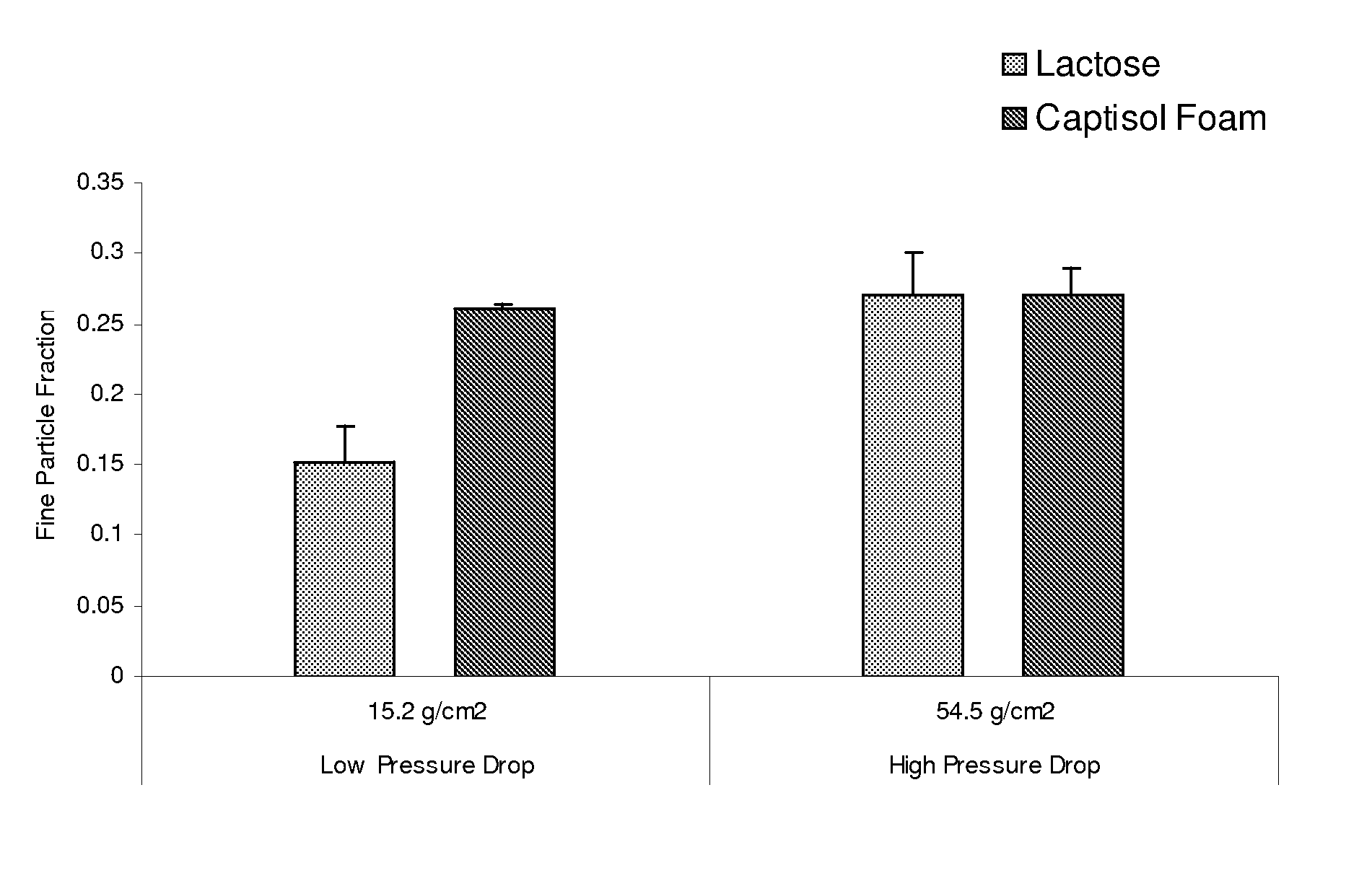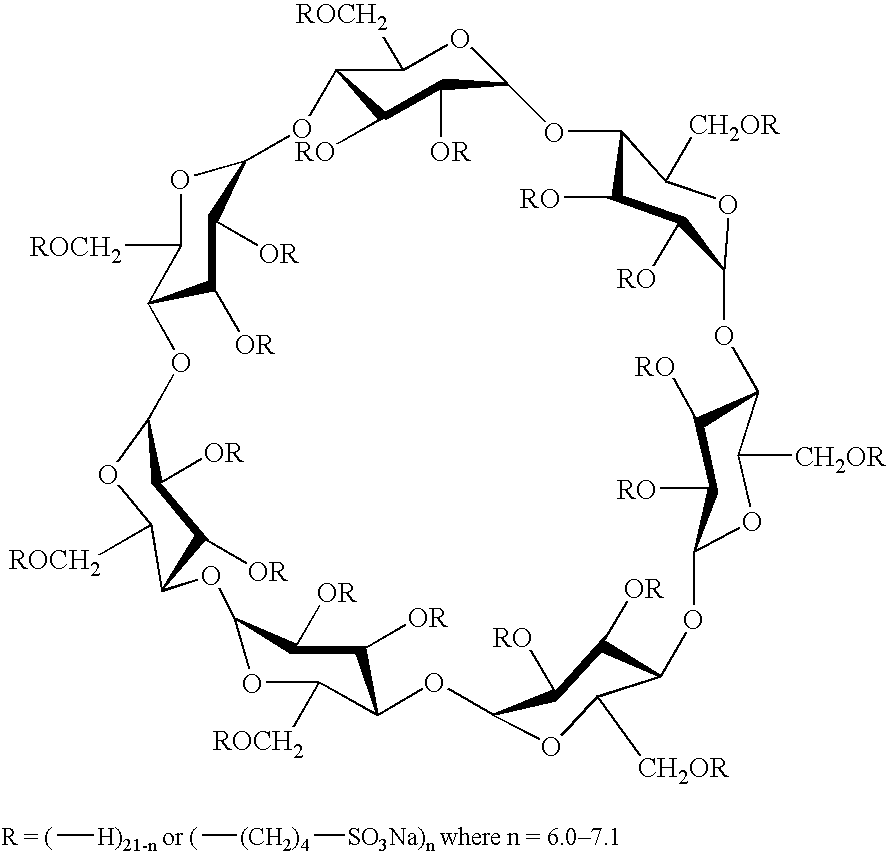Dpi formulation containing sulfoalkyl ether cyclodextrin
a technology of sulfoalkyl ether and cyclodextrin, which is applied in the direction of anti-inflammatory agents, drug compositions, immunological disorders, etc., can solve the problems of high dispersion, difficult to meet patients, and active dispersion devices are in development, and achieve high pressure drop
- Summary
- Abstract
- Description
- Claims
- Application Information
AI Technical Summary
Benefits of technology
Problems solved by technology
Method used
Image
Examples
example 1
[0246] Exemplary formulations according to the invention were made according to the following general procedures.
Method A
[0247] A solid composition comprising cyclodextrin is mixed with a solid composition comprising active agent until homogeneity. The materials are kept in a climate-controlled environment to minimize exposure thereof to excessive moisture. The cyclodextrin-containing and active agent-containing compositions contain less than about 10% wt. water. The process is preferably, but optionally, conducted under an anhydrous or substantially anhydrous (less than 30%, 20% or 10% R.H.) atmosphere. Mixing of the two compositions can also include simultaneous attritting thereof or attrition can be performed as a separate process step. For example, the cyclodextrin-containing composition and the active agent-containing compositions are each attritted separately prior to mixing. Following completion of mixing, the dry powder formulation is optionally partitioned into individual...
example 2
[0250] Preparation of SAE-CD-containing carrier.
Method A
[0251] An SAE-CD carrier is derived from a foam as follows. A solution of SAE-CD in water is provided and an inert gas is optionally bubbled through the solution. The solution should have a viscosity thick enough to permit formation of a foam. In general, SAE-CD is present at a concentration of about 10% to 80% wt. / wt., or 20% to 75% wt. / wt. or 30% to 65% wt. / wt. The solution is placed in a freezing apparatus equipped with an agitator. (An exemplary apparatus is the ELECTROFREEZE Model 30TN-CAD-132.) As the foam mixture is agitated, it is gradually frozen in the apparatus to form a frozen foam. The frozen foam is then dehydrated, such as by freeze-drying (lyophilizing), to form a friable porous material, which is attritted to provide a carrier having a suitable particle size range.
Method B
[0252] An SAE-CD carrier is prepared by spray agglomeration in an FSD-16 fluid spray drier apparatus as follows. Several solutions of Cap...
example 3
[0257] Determination of the particle size distribution of the dry powder formulation, the active agent-containing formulation and the SAE-CD-containing carrier.
[0258] The particle size distributions of lactose, maltodextrin and Captisol® were determined by laser diffraction (Malvern, 2600c, Malvern, UK), using the dry powder feeder attachment (Malvern, PS 40, Malvern, UK), running at 15 psi. The powder was sampled using 500 detector sweeps for statistical validity. The obscuration values were monitored to ensure adequate data acquisition. The 300 mm focal length detector lens was used, providing a size range of 5.8 to 564 mm. Other laser diffraction particle size measurements were performed by Cydex using a Horiba instrument.
[0259] The particle size analysis for an exemplary SAE-CD carrier prepared according to Method A of Example 2 is included in the table below.
Weight of Sample in% of total sampleSeive Size (μm)Seive (g)weightCumulative % Under Size2500.289514.0685.941800.1769...
PUM
| Property | Measurement | Unit |
|---|---|---|
| median particle diameter | aaaaa | aaaaa |
| median particle diameter | aaaaa | aaaaa |
| diameter | aaaaa | aaaaa |
Abstract
Description
Claims
Application Information
 Login to View More
Login to View More - R&D
- Intellectual Property
- Life Sciences
- Materials
- Tech Scout
- Unparalleled Data Quality
- Higher Quality Content
- 60% Fewer Hallucinations
Browse by: Latest US Patents, China's latest patents, Technical Efficacy Thesaurus, Application Domain, Technology Topic, Popular Technical Reports.
© 2025 PatSnap. All rights reserved.Legal|Privacy policy|Modern Slavery Act Transparency Statement|Sitemap|About US| Contact US: help@patsnap.com



